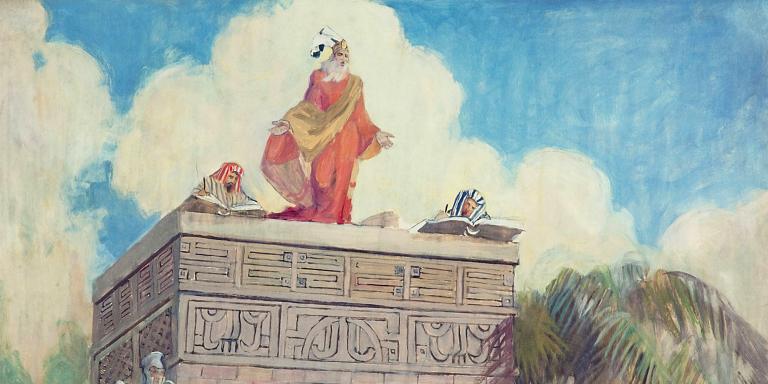
(Wikimedia Commons public domain image)
A new article appeared today in Interpreter: A Journal of Latter-day Saint Faith and Scholarship. This one is by Alan Goff:
“Working out Salvation History in the Book of Mormon Politeia with Fear and Trembling”
Review of James E. Faulconer, Mosiah: A Brief Theological Introduction (Provo, UT: Neal A. Maxwell Institute for Religious Scholarship, 2020). 135 pages. $9.95 (paperback).
Abstract: The Maxwell Institute for the Study of Religion has released another book in its series The Book of Mormon: Brief Theological Introductions. This book by James E. Faulconer more than ably engages five core elements of the book of Mosiah, exploring their theological implications. Faulconer puzzles through confusing passages and elements: why is the book rearranged so that it isn’t in chronological order? What might King Benjamin mean when he refers to the nothingness of humans? And what might Abinadi mean when he declares that Christ is both the Father and the Son? The most interesting parts of the introduction to Mosiah are those chapters that sort through the discussion of politics as both Alma1 and Mosiah2 sort out divine preferences in constitutional arrangements as the Nephites pass through a political revolution that shifts from rule by kings to rule by judges. Faulconer asserts that no particular political structure is preferred by God; in the chapter about economic arrangements, Faulconer (as in his analysis of political constitutions) asserts that deity doesn’t endorse any particular economic relationship.
***
In an effort to remind readers of the rich store of material that have been produced thus far by the Interpreter Foundation, I call attention to five more articles that were published in the first volume of our flagship publication, Interpreter: A Journal of Latter-day Saint Faith and Scholarship:
John L. Sorenson, “An Open Letter to Dr. Michael Coe”
Abstract: In August 2011 John Dehlin conducted a three-part interview with famed Mesoamericanist Michael Coe. ((Michael Coe, “Dr. Michael Coe—An Outsider’s View of Book of Mormon Archaeology,” podcast interview by John Dehlin, parts 1–3, at http://mormonstories.org/?p=1880; hereafter cited as “Coe interview.” Approximate time stamps are included in individual citations. A version of this open letter is also available on Sorenson’s own website and the FAIR website: http://johnlsorenson.com/docs/OpenLetterCoe.pdf. http://www.fairlds.org/authors/sorenson-john/an-open-letter-to-dr-michael-coe; the editors are grateful to Dr. Sorenson and FAIR for permission to reprint it here.)) Dehlin operates the podcast series Mormon Stories, which features interviews discussing the faith and culture of The Church of Jesus Christ of Latter-day Saints. This article examines a large number of dubious claims made in those interviews, providing clarifications, responses, and references to numerous sources dealing with those issues. Much more detail will be forthcoming in Dr. Sorenson’s new book, Mormon’s Codex.
Louis C. Midgley, “Atheist Piety: A Religion of Dogmatic Dubiety”
Abstract: The “Special Feature” of this mass-market secular humanist magazine consists of an introduction to “America’s Peculiar Piety” followed by a miscellany of brief, nonscholarly essays critical of The Church of Jesus Christ. The questions posed in the introduction to this flagship atheist magazine go unaddressed in the essays. Some of the essays are personal exit stories by former Latter-day Saints. One is an effort by Robert M. Price to explain away the Book of Mormon without confronting its contents. This is done by ignoring the details of Joseph Smith’s career in order to picture him as the equivalent of a bizarre, emotionally conflicted figure like Charles Manson or as the embodiment of one of a wide range of mythical trickster figures like Brer Rabbit, Felix the Cat, or Doctor Who. The assumed link between these mythical or legendary figures and Joseph Smith is said to be a Jungian archetype lodged in his presumably deranged psyche, leading him to fashion the Book of Mormon.
Another essay merely mentions the well-known criticisms of Joseph Smith by Abner Cole (a.k.a. Obadiah Dogberry), while others complain that the faith of the Saints tends to meet emotional needs or that their religious community has various ways of reinforcing their own moral demands. In no instance do these authors see their own deeply held ideology as serving similar personal and community-sustaining religious functions.
All of the essays reflect a fashionable, dogmatic, naive, and deeply religious enmity toward the faith of Latter-day Saints. The essays are also shown to be instances of a modern [Page 112]militant atheism, which is contrasted with earlier and much less bold and aggressive doubts about divine things. The ideological links between those responsible for Free Inquiry and some critics on the fringes of the LDS community are also clearly identified.
Review of Tom Flynn et al. “America’s Peculiar Piety: Why Did Mormonism Grow? Why Does It Endure?” Free Inquiry, October/November 2011, 21–41.
Robert M. Price. Latter-day Scripture: Studies in the Book of Mormon. Self-published e-book, 2011 (http://www.eBookIt.com). 78 pp., no index, no pagination. $10.95.
Roger Nicholson, “Mormonism and Wikipedia: The Church History That “Anyone Can Edit””
Abstract: The ability to quickly and easily access literature critical of The Church of Jesus Christ of Latter-day Saints has been made significantly easier through the advent of the Internet. One of the primary sites that dominates search engine results is Wikipedia, an online encyclopedia that “anyone can edit.” Wikipedia contains a large number of articles related to Mormonism that are edited by believers, critics, and neutral parties. The reliability of information regarding the Church and its history is subject to the biases of the editors who choose to modify those articles. Even if a wiki article is thoroughly sourced, editors sometimes employ source material in a manner that supports their bias. This essay explores the dynamics behind the creation of Wikipedia articles about the Church, the role that believers and critics play in that process, and the reliability of the information produced in the resulting wiki articles.
Ralph C. Hancock, “To Really Read the Book of Mormon”
Review of Grant Hardy. Understanding the Book of Mormon: A Reader’s Guide. New York: Oxford University Press, 2010. xix + 346 pp., with index. $29.95.
***
And, of course, don’t forget this:
“The Official “Witnesses” Poster and Trailer Are Now Available”











